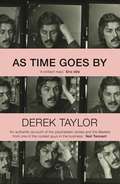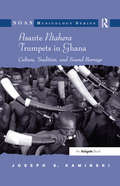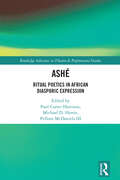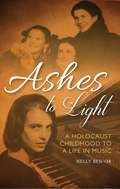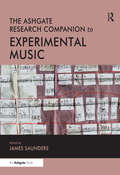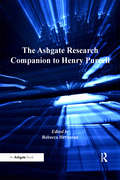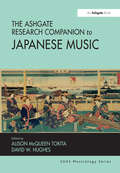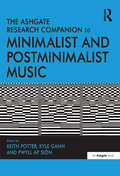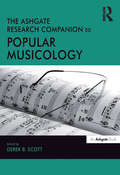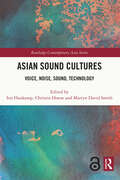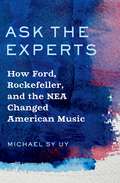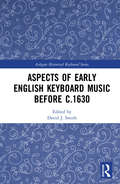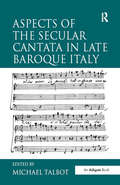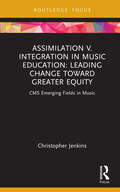- Table View
- List View
As Time Goes By: Living In The Sixties (Rock And Roll Remembrances Ser. #No. 3)
by Derek Taylor'The sharpest memoir written by one of the Beatles' inner circle.' ObserverDerek Taylor's iconic memoir is a rare opportunity to be immersed in one of the most whirlwind music sensations in history: Beatlemania. As Time Goes By tells the remarkable story of Taylor's trajectory from humble provincial journalist to loved confidant right at the centre of the Beatles' magic circle. In charming, conversational prose, Taylor shares anecdotes and reminiscences so vivid and immediate that you find yourself plunged into the beating heart of 1960s counterculture. Whether watching the debut performance of 'Hey Jude' in a country pub or hearing first-hand gossip about a star-studded cast of characters, Taylor's unique narrative voice forges an autobiography like no other. Reissued here in a brand new edition with a foreword by celebrated writer Jon Savage, this long-admired memoir is a cult classic of the genre awaiting a new readership.
Asante Ntahera Trumpets in Ghana: Culture, Tradition, and Sound Barrage (SOAS Studies in Music)
by Joseph S.KaminskiBased on the author's fieldwork in Ghana with the Asante and Denkyira ntahera trumpeters, this book draws on interviews, field recordings, oral traditions, written accounts, archaeological evidence, transcriptions and linguistic analyses to situate the Asante trumpet tradition in historical culture. There are seven ivory trumpet ensembles in residence at the Asante Manhyia Palace in Kumase, and ivory trumpets are blown at every Akan court. The Asante trumpets, which are made from elephant tusks, are symbols of Asante strength and have an important role in Asante cosmology. Surrogate speech is performed via lipped tones through a tusk in praise of the Asante royal ancestors and the living Asante king. This book contains transcriptions and analyses of surrogate speech texts and their accompanying ensemble songs. When several ensembles play simultaneously as a representation of power, they make staggered entrances, beginning separate songs in order. This results in a simultaneous performance of separate songs. This phenomenon, which Kaminski has termed 'sound-barrage', is an ancient aesthetic, and is performed to protect the kingdom and the ancestors. It is both spiritual and acoustical. This 'sound barrage' is believed to act in the metaphysical world, dispelling evil spirits from court rituals, ancestor venerations, and funerals, for there is a spirit in the sound.
Asante Ntahera Trumpets in Ghana: Culture, Tradition, and Sound Barrage (SOAS Studies in Music)
by Joseph S.KaminskiBased on the author's fieldwork in Ghana with the Asante and Denkyira ntahera trumpeters, this book draws on interviews, field recordings, oral traditions, written accounts, archaeological evidence, transcriptions and linguistic analyses to situate the Asante trumpet tradition in historical culture. There are seven ivory trumpet ensembles in residence at the Asante Manhyia Palace in Kumase, and ivory trumpets are blown at every Akan court. The Asante trumpets, which are made from elephant tusks, are symbols of Asante strength and have an important role in Asante cosmology. Surrogate speech is performed via lipped tones through a tusk in praise of the Asante royal ancestors and the living Asante king. This book contains transcriptions and analyses of surrogate speech texts and their accompanying ensemble songs. When several ensembles play simultaneously as a representation of power, they make staggered entrances, beginning separate songs in order. This results in a simultaneous performance of separate songs. This phenomenon, which Kaminski has termed 'sound-barrage', is an ancient aesthetic, and is performed to protect the kingdom and the ancestors. It is both spiritual and acoustical. This 'sound barrage' is believed to act in the metaphysical world, dispelling evil spirits from court rituals, ancestor venerations, and funerals, for there is a spirit in the sound.
ASHÉ: Ritual Poetics in African Diasporic Expression (Routledge Advances in Theatre & Performance Studies)
by Paul Carter Harrison Michael D. Harris Pellom McDaniels III‘ASHÉ: Ritual Poetics in African Diasporic Expressivity' is a collection of interdisciplinary essays contributed by international scholars and practitioners. Having distinguished themselves across such disciplines as Anthropology, Art, Music, Literature, Dance, Philosophy, Religion, and Theology and conjoined to construct a defining approach to the study of Aesthetics throughout the African Diaspora with the Humanities at the core, this collection of essays will break new ground in the study of Black Aesthetics. This book will be of great interest to scholars, practitioners, and students interested in tracing African heritage identities throughout the African Diaspora through close examination of a variety of discourses directly connected to expressive elements of cultural production and religious rituals.
ASHÉ: Ritual Poetics in African Diasporic Expression (Routledge Advances in Theatre & Performance Studies)
by Paul Carter Harrison Michael D. Harris Pellom McDaniels III‘ASHÉ: Ritual Poetics in African Diasporic Expressivity' is a collection of interdisciplinary essays contributed by international scholars and practitioners. Having distinguished themselves across such disciplines as Anthropology, Art, Music, Literature, Dance, Philosophy, Religion, and Theology and conjoined to construct a defining approach to the study of Aesthetics throughout the African Diaspora with the Humanities at the core, this collection of essays will break new ground in the study of Black Aesthetics. This book will be of great interest to scholars, practitioners, and students interested in tracing African heritage identities throughout the African Diaspora through close examination of a variety of discourses directly connected to expressive elements of cultural production and religious rituals.
Ashes to Light: A Holocaust Childhood to a Life in Music
by Nelly Ben-OrBorn into a Jewish family in Lvov, Poland in the early-1930s, Nelly Ben-Or was to experience, at a very young age, the trauma of the Holocaust. This narrative of her life's journey describes the miraculous survival of Nelly, her mother and her older sister. With help from family and friends, Nelly and her mother were smuggled out of the Ghetto in Lvov and escaped to Warsaw with false identity papers where they were under constant threat of discovery as Jews were sent to concentration camps and murdered. They then survived being taken on a train to Auschwitz, not, in fact, because they were Jews, but as citizens of Warsaw following the Warsaw Uprising against the Nazis. No less miraculous was how her innate musical talent survived and was even occasionally able to reveal itself, during these Holocaust years. After the war, they were reunited with Nelly's sister, who had remained in hiding in Lvov.
The Ashgate Research Companion to Experimental Music (Routledge Music Companions)
by James SaundersThe recent resurgence of experimental music has given rise to a more divergent range of practices than has previously been the case. The Ashgate Research Companion to Experimental Music reflects these recent developments by providing examples of current thinking and presenting detailed case studies that document the work of contemporary figures. The book examines fourteen current practitioners by interrogating their artistic practices through annotated interviews, contextualized by nine authored chapters which explore central issues that emerge from and inform these discussions. Whilst focusing on composition, the book also encompasses related aspects of performance, improvisation and sonic art. The interviews all explore how the selected artists work, focusing on the processes involved in developing their recent projects, set against more general aesthetic concerns. They aim to shed light on the disparate nature of current work whilst seeking to find possible points of contact. Many of the practitioners are active in areas that span disciplines, such as composition and improvisation, and the book explores the interaction of these activities in the context of their work. The other chapters consider a range of issues pertinent to recent developments in the genre, including: definitions of experimentalism and its relationship with a broader avant garde; experimentalism and cultural change; notation and its effect on composition; realising open scores; issues of notation and interpretation in live electronic music; performing experimental music; improvisation and technology; improvisation and social meaning; instrumentalizing objects; visual artists' relationships to experimental music; working across interdisciplinary boundaries; listening and the soundscape; working methods, techniques and aesthetics of recent experimental music.
The Ashgate Research Companion to Experimental Music (Routledge Music Companions)
by James SaundersThe recent resurgence of experimental music has given rise to a more divergent range of practices than has previously been the case. The Ashgate Research Companion to Experimental Music reflects these recent developments by providing examples of current thinking and presenting detailed case studies that document the work of contemporary figures. The book examines fourteen current practitioners by interrogating their artistic practices through annotated interviews, contextualized by nine authored chapters which explore central issues that emerge from and inform these discussions. Whilst focusing on composition, the book also encompasses related aspects of performance, improvisation and sonic art. The interviews all explore how the selected artists work, focusing on the processes involved in developing their recent projects, set against more general aesthetic concerns. They aim to shed light on the disparate nature of current work whilst seeking to find possible points of contact. Many of the practitioners are active in areas that span disciplines, such as composition and improvisation, and the book explores the interaction of these activities in the context of their work. The other chapters consider a range of issues pertinent to recent developments in the genre, including: definitions of experimentalism and its relationship with a broader avant garde; experimentalism and cultural change; notation and its effect on composition; realising open scores; issues of notation and interpretation in live electronic music; performing experimental music; improvisation and technology; improvisation and social meaning; instrumentalizing objects; visual artists' relationships to experimental music; working across interdisciplinary boundaries; listening and the soundscape; working methods, techniques and aesthetics of recent experimental music.
The Ashgate Research Companion to Henry Purcell (Routledge Music Companions)
by Rebecca HerissoneThe Ashgate Research Companion to Henry Purcell provides a comprehensive and authoritative review of current research into Purcell and the environment of Restoration music, with contributions from leading experts in the field. Seen from the perspective of modern, interdisciplinary approaches to scholarship, the companion allows the reader to develop a rounded view of the environment in which Purcell lived, the people with whom he worked, the social conditions that influenced his activities, and the ways in which the modern perception of him has been affected by reception of his music after his death. In this sense the contributions do not privilege the individual over the environment: rather, they use the modern reader's familiarity with Purcell's music as a gateway into the broader Restoration world. Topics include a reassessment of our understanding of Purcell's sources and the transmission of his music; new ways of approaching the study of his creative methods; performance practice; the multi-faceted theatre environment in which his work was focused in the last five years of his life; the importance of the political and social contexts of late seventeenth-century England; and the ways in which the performance history and reception of his music have influenced modern appreciation of the composer. The book will be essential reading for anyone studying the music and culture of the seventeenth century.
The Ashgate Research Companion to Henry Purcell (Routledge Music Companions)
by Rebecca HerissoneThe Ashgate Research Companion to Henry Purcell provides a comprehensive and authoritative review of current research into Purcell and the environment of Restoration music, with contributions from leading experts in the field. Seen from the perspective of modern, interdisciplinary approaches to scholarship, the companion allows the reader to develop a rounded view of the environment in which Purcell lived, the people with whom he worked, the social conditions that influenced his activities, and the ways in which the modern perception of him has been affected by reception of his music after his death. In this sense the contributions do not privilege the individual over the environment: rather, they use the modern reader's familiarity with Purcell's music as a gateway into the broader Restoration world. Topics include a reassessment of our understanding of Purcell's sources and the transmission of his music; new ways of approaching the study of his creative methods; performance practice; the multi-faceted theatre environment in which his work was focused in the last five years of his life; the importance of the political and social contexts of late seventeenth-century England; and the ways in which the performance history and reception of his music have influenced modern appreciation of the composer. The book will be essential reading for anyone studying the music and culture of the seventeenth century.
The Ashgate Research Companion to Japanese Music (SOAS Studies in Music)
by David W. HughesMusic is a frequently neglected aspect of Japanese culture. It is in fact a highly problematic area, as the Japanese actively introduced Western music into their modern education system in the Meiji period (1868-1911), creating westernized melodies and instrumental instruction for Japanese children from kindergarten upwards. As a result, most Japanese now have a far greater familiarity with Western (or westernized) music than with traditional Japanese music. Traditional or classical Japanese music has become somewhat ghettoized, often known and practised only by small groups of people in social structures which have survived since the pre-modern era. Such marginalization of Japanese music is one of the less recognized costs of Japan's modernization. On the other hand, music in its westernized and modernized forms has an extremely important place in Japanese culture and society, Beethoven's Ninth Symphony, for example, being so widely known and performed that it is arguably part of contemporary Japanese popular and mass culture. Japan has become a world leader in the mass production of Western musical instruments and in innovative methodologies of music education (Yamaha and Suzuki). More recently, the Japanese craze of karaoke as a musical entertainment and as musical hardware has made an impact on the leisure and popular culture of many countries in Asia, Europe and the Americas. This is the first book to cover in detail all genres including court music, Buddhist chant, theatre music, chamber ensemble music and folk music, as well as contemporary music and the connections between music and society in various periods. The book is a collaborative effort, involving both Japanese and English speaking authors, and was conceived by the editors to form a balanced approach that comprehensively treats the full range of Japanese musical culture.
The Ashgate Research Companion to Japanese Music (SOAS Studies in Music)
by David W. HughesMusic is a frequently neglected aspect of Japanese culture. It is in fact a highly problematic area, as the Japanese actively introduced Western music into their modern education system in the Meiji period (1868-1911), creating westernized melodies and instrumental instruction for Japanese children from kindergarten upwards. As a result, most Japanese now have a far greater familiarity with Western (or westernized) music than with traditional Japanese music. Traditional or classical Japanese music has become somewhat ghettoized, often known and practised only by small groups of people in social structures which have survived since the pre-modern era. Such marginalization of Japanese music is one of the less recognized costs of Japan's modernization. On the other hand, music in its westernized and modernized forms has an extremely important place in Japanese culture and society, Beethoven's Ninth Symphony, for example, being so widely known and performed that it is arguably part of contemporary Japanese popular and mass culture. Japan has become a world leader in the mass production of Western musical instruments and in innovative methodologies of music education (Yamaha and Suzuki). More recently, the Japanese craze of karaoke as a musical entertainment and as musical hardware has made an impact on the leisure and popular culture of many countries in Asia, Europe and the Americas. This is the first book to cover in detail all genres including court music, Buddhist chant, theatre music, chamber ensemble music and folk music, as well as contemporary music and the connections between music and society in various periods. The book is a collaborative effort, involving both Japanese and English speaking authors, and was conceived by the editors to form a balanced approach that comprehensively treats the full range of Japanese musical culture.
The Ashgate Research Companion to Minimalist and Postminimalist Music (Routledge Music Companions)
by Keith Potter Kyle GannIn recent years the music of minimalist composers such as La Monte Young, Terry Riley, Steve Reich and Philip Glass has, increasingly, become the subject of important musicological reflection, research and debate. Scholars have also been turning their attention to the work of lesser-known contemporaries such as Phill Niblock and Eliane Radigue, or to second and third generation minimalists such as John Adams, Louis Andriessen, Michael Nyman and William Duckworth, whose range of styles may undermine any sense of shared aesthetic approach but whose output is still to a large extent informed by the innovative work of their minimalist predecessors. Attempts have also been made by a number of academics to contextualise the work of composers who have moved in parallel with these developments while remaining resolutely outside its immediate environment, including such diverse figures as Karel Goeyvaerts, Robert Ashley, Arvo Pärt and Brian Eno. Theory has reflected practice in many respects, with the multimedia works of Reich and Glass encouraging interdisciplinary approaches, associations and interconnections. Minimalism’s role in culture and society has also become the subject of recent interest and debate, complementing existing scholarship, which addressed the subject from the perspective of historiography, analysis, aesthetics and philosophy. The Ashgate Research Companion to Minimalist and Postminimalist Music provides an authoritative overview of established research in this area, while also offering new and innovative approaches to the subject.
The Ashgate Research Companion to Minimalist and Postminimalist Music (Routledge Music Companions)
by Keith Potter Kyle GannIn recent years the music of minimalist composers such as La Monte Young, Terry Riley, Steve Reich and Philip Glass has, increasingly, become the subject of important musicological reflection, research and debate. Scholars have also been turning their attention to the work of lesser-known contemporaries such as Phill Niblock and Eliane Radigue, or to second and third generation minimalists such as John Adams, Louis Andriessen, Michael Nyman and William Duckworth, whose range of styles may undermine any sense of shared aesthetic approach but whose output is still to a large extent informed by the innovative work of their minimalist predecessors. Attempts have also been made by a number of academics to contextualise the work of composers who have moved in parallel with these developments while remaining resolutely outside its immediate environment, including such diverse figures as Karel Goeyvaerts, Robert Ashley, Arvo Pärt and Brian Eno. Theory has reflected practice in many respects, with the multimedia works of Reich and Glass encouraging interdisciplinary approaches, associations and interconnections. Minimalism’s role in culture and society has also become the subject of recent interest and debate, complementing existing scholarship, which addressed the subject from the perspective of historiography, analysis, aesthetics and philosophy. The Ashgate Research Companion to Minimalist and Postminimalist Music provides an authoritative overview of established research in this area, while also offering new and innovative approaches to the subject.
The Ashgate Research Companion to Popular Musicology (Routledge Music Companions)
by Derek B. ScottThe research presented in this volume is very recent, and the general approach is that of rethinking popular musicology: its purpose, its aims, and its methods. Contributors to the volume were asked to write something original and, at the same time, to provide an instructive example of a particular way of working and thinking. The essays have been written with a view to helping graduate students with research methodology and the application of relevant theoretical models. The team of contributors is an exceptionally strong one: it contains many of the pre-eminent academic figures involved in popular musicological research, and there is a spread of European, American, Asian, and Australasian scholars. The volume covers seven main themes: Film, Video and Multimedia; Technology and Studio Production; Gender and Sexuality; Identity and Ethnicity; Performance and Gesture; Reception and Scenes and The Music Industry and Globalization. The Ashgate Research Companion is designed to offer scholars and graduate students a comprehensive and authoritative state-of-the-art review of current research in a particular area. The companion's editor brings together a team of respected and experienced experts to write chapters on the key issues in their speciality, providing a comprehensive reference to the field.
The Ashgate Research Companion to Popular Musicology (Routledge Music Companions)
by Derek B. ScottThe research presented in this volume is very recent, and the general approach is that of rethinking popular musicology: its purpose, its aims, and its methods. Contributors to the volume were asked to write something original and, at the same time, to provide an instructive example of a particular way of working and thinking. The essays have been written with a view to helping graduate students with research methodology and the application of relevant theoretical models. The team of contributors is an exceptionally strong one: it contains many of the pre-eminent academic figures involved in popular musicological research, and there is a spread of European, American, Asian, and Australasian scholars. The volume covers seven main themes: Film, Video and Multimedia; Technology and Studio Production; Gender and Sexuality; Identity and Ethnicity; Performance and Gesture; Reception and Scenes and The Music Industry and Globalization. The Ashgate Research Companion is designed to offer scholars and graduate students a comprehensive and authoritative state-of-the-art review of current research in a particular area. The companion's editor brings together a team of respected and experienced experts to write chapters on the key issues in their speciality, providing a comprehensive reference to the field.
Asian Sound Cultures: Voice, Noise, Sound, Technology (Routledge Contemporary Asia Series)
by Iris Haukamp Christin Hoene Martyn David SmithThis book examines the meanings, uses, and agency of voice, noise, sound, and sound technologies across Asia. Including a series of wide-ranging and interdisciplinary case studies, the book reveals sound as central to the experience of modernity in Asia and as essential to the understanding of the historical processes of cultural, social, political, and economic transformation throughout the long twentieth century. Presenting a broad range of topics – from the changing sounds of the Kyoto kimono making industry to radio in late colonial India – the book explores how the study of Asian sound cultures offers greater insight into historical accounts of local and global transformation. Challenging us to rethink and reassemble important categories in sound studies, this book will be a vital resource for students and scholars of sound studies, Asian studies, history, postcolonial studies, and media studies.
Asian Sound Cultures: Voice, Noise, Sound, Technology (Routledge Contemporary Asia Series)
by Iris Haukamp Christin Hoene Martyn David SmithThis book examines the meanings, uses, and agency of voice, noise, sound, and sound technologies across Asia. Including a series of wide-ranging and interdisciplinary case studies, the book reveals sound as central to the experience of modernity in Asia and as essential to the understanding of the historical processes of cultural, social, political, and economic transformation throughout the long twentieth century. Presenting a broad range of topics – from the changing sounds of the Kyoto kimono making industry to radio in late colonial India – the book explores how the study of Asian sound cultures offers greater insight into historical accounts of local and global transformation. Challenging us to rethink and reassemble important categories in sound studies, this book will be a vital resource for students and scholars of sound studies, Asian studies, history, postcolonial studies, and media studies.
Ask the Experts: How Ford, Rockefeller, and the NEA Changed American Music
by Michael Sy UyFrom the end of the Second World War through the U.S. Bicentennial, the National Endowment for the Arts, the Rockefeller Foundation, and the Ford Foundation granted close to $300 million (approximately $2.3 billion in 2017 dollars) in the field of music alone. In deciding what to fund, these three grantmaking institutions decided to "ask the experts," adopting seemingly objective, scientific models of peer review and specialist evaluation. They recruited music composers at elite institutions, professors from prestigious universities, and leaders of performing arts organizations. Among the most influential expert-consultants were Leonard Bernstein, Aaron Copland, Lukas Foss, and Milton Babbitt. The significance was two-fold: not only were male, Western art composers put in charge of directing large and unprecedented channels of public and private funds, but in doing so they also determined and defined what was meant by artistic excellence. They decided the fate of their peers and shaped the direction of music-making in this country. By asking the experts, the grantmaking institutions produced a concentrated and interconnected field of artists and musicians. Officers and directors utilized ostensibly objective financial tools like matching grants and endowments in an attempt to diversify and stabilize applicants' sources of funding, as well as the number of applicants they funded. Such economics-based strategies, however, relied more on personal connections among the wealthy and elite, rather than local community citizens. Ultimately, this history demonstrates how "expertise" served as an exclusionary form of cultural and social capital that prevented racial minorities and non-dominant groups from fully participating.
Ask the Experts: How Ford, Rockefeller, and the NEA Changed American Music
by Michael Sy UyFrom the end of the Second World War through the U.S. Bicentennial, the National Endowment for the Arts, the Rockefeller Foundation, and the Ford Foundation granted close to $300 million (approximately $2.3 billion in 2017 dollars) in the field of music alone. In deciding what to fund, these three grantmaking institutions decided to "ask the experts," adopting seemingly objective, scientific models of peer review and specialist evaluation. They recruited music composers at elite institutions, professors from prestigious universities, and leaders of performing arts organizations. Among the most influential expert-consultants were Leonard Bernstein, Aaron Copland, Lukas Foss, and Milton Babbitt. The significance was two-fold: not only were male, Western art composers put in charge of directing large and unprecedented channels of public and private funds, but in doing so they also determined and defined what was meant by artistic excellence. They decided the fate of their peers and shaped the direction of music-making in this country. By asking the experts, the grantmaking institutions produced a concentrated and interconnected field of artists and musicians. Officers and directors utilized ostensibly objective financial tools like matching grants and endowments in an attempt to diversify and stabilize applicants' sources of funding, as well as the number of applicants they funded. Such economics-based strategies, however, relied more on personal connections among the wealthy and elite, rather than local community citizens. Ultimately, this history demonstrates how "expertise" served as an exclusionary form of cultural and social capital that prevented racial minorities and non-dominant groups from fully participating.
Aspects of Early English Keyboard Music before c.1630 (Ashgate Historical Keyboard Series)
by David J. SmithEnglish keyboard music reached an unsurpassed level of sophistication in the late sixteenth and early seventeenth centuries as organists such as William Byrd and his students took a genre associated with domestic, amateur performance and treated it as seriously as vocal music. This book draws together important research on the music, its sources and the instruments on which it was played. There are two chapters on instruments: John Koster on the use of harpsichord during the period, and Dominic Gwynn on the construction of Tudor-style organs based on the surviving evidence we have for them. This leads to a section devoted to organ performance practice in a liturgical context, in which John Harper discusses what the use of organs pitched in F may imply about their use in alternation with vocal polyphony, and Magnus Williamson explores improvisational practice in the Tudor period. The next section is on sources and repertoire, beginning with Frauke Jürgensen and Rachelle Taylor’s chapter on Clarifica me Pater settings, which grows naturally out of the consideration of improvisation in the previous chapter. The next two contributions focus on two of the most important individual manuscript sources: Tihomir Popović challenges assumptions about My Ladye Nevells Booke by reflecting on what the manuscript can tell us about aristocratic culture, and David J. Smith provides a detailed study of the famous Fitzwilliam Virginal Book. The discussion then broadens out into Pieter Dirksen’s consideration of a wider selection of sources relating to John Bull, which in turn connects closely to David Leadbetter’s work on Gibbons, lute sources and questions of style.
Aspects of Early English Keyboard Music before c.1630 (Ashgate Historical Keyboard Series)
by David J. SmithEnglish keyboard music reached an unsurpassed level of sophistication in the late sixteenth and early seventeenth centuries as organists such as William Byrd and his students took a genre associated with domestic, amateur performance and treated it as seriously as vocal music. This book draws together important research on the music, its sources and the instruments on which it was played. There are two chapters on instruments: John Koster on the use of harpsichord during the period, and Dominic Gwynn on the construction of Tudor-style organs based on the surviving evidence we have for them. This leads to a section devoted to organ performance practice in a liturgical context, in which John Harper discusses what the use of organs pitched in F may imply about their use in alternation with vocal polyphony, and Magnus Williamson explores improvisational practice in the Tudor period. The next section is on sources and repertoire, beginning with Frauke Jürgensen and Rachelle Taylor’s chapter on Clarifica me Pater settings, which grows naturally out of the consideration of improvisation in the previous chapter. The next two contributions focus on two of the most important individual manuscript sources: Tihomir Popović challenges assumptions about My Ladye Nevells Booke by reflecting on what the manuscript can tell us about aristocratic culture, and David J. Smith provides a detailed study of the famous Fitzwilliam Virginal Book. The discussion then broadens out into Pieter Dirksen’s consideration of a wider selection of sources relating to John Bull, which in turn connects closely to David Leadbetter’s work on Gibbons, lute sources and questions of style.
Aspects of the Secular Cantata in Late Baroque Italy
by Michael TalbotAs shown by the ever-increasing volume of recordings, editions and performances of the vast repertory of secular cantatas for solo voice produced, primarily in Italy, in the second half of the seventeenth century and the first half of the eighteenth century, this long neglected genre has at last 'come of age'. However, scholarly interest is currently lagging behind musical practice: incredibly, there has been no general study of the Baroque cantata since Eugen Schmitz's handbook of 1914, and although many academic theses have examined microscopically the cantatas of individual composers, there has been little opportunity to view these against the broader canvas of the genre as a whole. The contributors in this volume choose aspects of the cantata relevant to their special interests in order to say new things about the works, whether historical, analytical, bibliographical, discographical or performance-based. The prime focus is on Italian-born composers working between 1650 and 1750 (thus not Handel), but the opportunity is also taken in one chapter (by Graham Sadler) to compare the French cantata tradition with its Italian parent in association with a startling new claim regarding the intended instrumentation. Many key figures are considered, among them Tomaso Albinoni, Giovanni Bononcini, Giovanni Legrenzi, Benedetto Marcello, Alessandro Scarlatti, Alessandro Stradella, Leonardo Vinci and Antonio Vivaldi. The poetic texts of the cantatas, all too often treated as being of little intrinsic interest, are given their due weight. Space is also found for discussions of the history of Baroque solo cantatas on disc and of the realization of the continuo in cantata arias - a topic more complex and contentious than may at first be apparent. The book aims to stimulate interest in, and to win converts to, this genre, which in its day equalled the instrumental sonata in importance, and in which more than a few composers invested a major part of their creativity.
Aspects of the Secular Cantata in Late Baroque Italy
by Michael TalbotAs shown by the ever-increasing volume of recordings, editions and performances of the vast repertory of secular cantatas for solo voice produced, primarily in Italy, in the second half of the seventeenth century and the first half of the eighteenth century, this long neglected genre has at last 'come of age'. However, scholarly interest is currently lagging behind musical practice: incredibly, there has been no general study of the Baroque cantata since Eugen Schmitz's handbook of 1914, and although many academic theses have examined microscopically the cantatas of individual composers, there has been little opportunity to view these against the broader canvas of the genre as a whole. The contributors in this volume choose aspects of the cantata relevant to their special interests in order to say new things about the works, whether historical, analytical, bibliographical, discographical or performance-based. The prime focus is on Italian-born composers working between 1650 and 1750 (thus not Handel), but the opportunity is also taken in one chapter (by Graham Sadler) to compare the French cantata tradition with its Italian parent in association with a startling new claim regarding the intended instrumentation. Many key figures are considered, among them Tomaso Albinoni, Giovanni Bononcini, Giovanni Legrenzi, Benedetto Marcello, Alessandro Scarlatti, Alessandro Stradella, Leonardo Vinci and Antonio Vivaldi. The poetic texts of the cantatas, all too often treated as being of little intrinsic interest, are given their due weight. Space is also found for discussions of the history of Baroque solo cantatas on disc and of the realization of the continuo in cantata arias - a topic more complex and contentious than may at first be apparent. The book aims to stimulate interest in, and to win converts to, this genre, which in its day equalled the instrumental sonata in importance, and in which more than a few composers invested a major part of their creativity.
Assimilation v. Integration in Music Education: Leading Change toward Greater Equity (CMS Emerging Fields in Music)
by Christopher JenkinsAssimilation v. Integration in Music Education engages with an existential question for American conservatories and orchestras: What does it mean to diversify Western classical music? Many institutions have focused solely on diversifying the demography of their participants, but without a deeper conversation about structural oppression in classical music, this approach continues to isolate and exclude students of color. Rooted in the author’s experience working with BIPOC (Black, Indigenous, and People of Color) students at a major American conservatory, this book articulates the issues facing minority students in conservatories and schools of music, going beyond recruitment to address the cultural issues that alienate students. The author argues that the issue of diversity should be approached through the lens of aesthetics, and that the performance and pedagogy of Western classical music must change if a more diverse membership is to thrive in this genre. Reflecting on the author’s experience through the lens of recent critical theory in music education, this volume presents the viewpoints of Black and Latinx music students in their own words. Addressing the impact of racialized aesthetics on the well-being of BIPOC music students, the author shows how students are alienated when attempting to assimilate into conservatory environments and envisions an alternative, integrative approach to conservatory education. Offering a deep dive into the psychological and cultural reasons for the racialization of Western classical music, and potential institutional solutions, this concise book is relevant to performers, students, and institutional leaders.
